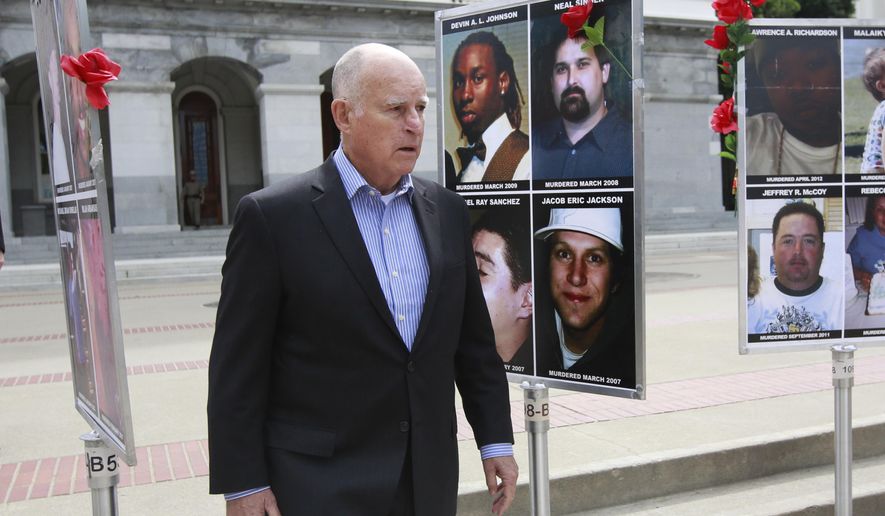SACRAMENTO, Calif. (AP) - One of the advantages of being in government for 50 years, says California Gov. Jerry Brown, is “you get to make mistakes that you then get to correct.”
For Brown, one of those missteps was the criminal justice overhaul he oversaw as a young governor during two terms from 1975 to 1983. Now 80, he leaves office Monday after again reshaping the system during the past eight years.
Get-tough sentencing laws during and after his first stint helped lead to the mass incarceration that crowded state prisons to the bursting point, spurring a federal takeover of many prison operations and a cap on the inmate population. The Democratic governor spent much of his second stint in office reducing criminal penalties and shuffling less-serious offenders to county jails instead of state lockups.
“He has done an immense amount to advance smart approaches to justice,” said Lenore Anderson, founder and executive director of the reform group Californians for Safety and Justice, calling it a “remarkable legacy.”
Brown said one of his biggest mistakes in his first two terms was signing the state’s current sentencing law in 1977, letting judges instead of parole boards decide when most convicts should be released. He said he thought at the time sentencing rules were too uncertain and criminals needed “clear, certain punishment.”
A 1978 study by two University of California, Berkeley law professors called the California sentencing reform an “event of national significance” as it limited parole boards’ “almost awesome freedom” with a “new philosophical approach.”
But it had the unintended consequence of dramatically lengthening prison sentences, particularly after lawmakers added hundreds of enhancements for things like using a gun, being a repeat offender or being involved in a gang while committing the underlying crime.
“It was an enormous social experiment in criminal justice,” recalled San Mateo County District Attorney Steve Wagstaffe, who started in the district attorney’s office the year Brown first took office. “They’ve been saying the same thing about the last seven years. They were saying then, ’This is an experiment, this is a gamble, and we don’t know how it’s going to work.’”
Brown’s voter-approved 2016 ballot measure helped restore some of the flexibility that was lost 40 years ago by allowing most offenders to seek earlier parole hearings. Critics want to scale back the law with a ballot question in 2020 because they think it’s too lenient. Among Brown’s final acts as governor was to file a lawsuit to try to block the question.
He also reduced criminal penalties and kept lower-level felons in county jails instead of state prisons. Voters separately eased sentences for career criminals, drug users and petty thieves.
The result is about 25 percent fewer inmates in California prisons.
“California has been a leader in criminal justice reform, in proposing large solutions, but also because it has had large problems,” said Nazgol Ghandnoosh, a senior research analyst at The Sentencing Project, a Washington, D.C.-based reform group.
The state’s longest-serving governor also eclipsed records dating to at least the 1940s in granting pardons and commutations. His 284 commutations are nearly double the number granted by his eight most recent predecessors combined. His 1,736 pardons are more than triple the number issued by his next most prolific modern predecessor, Republican Ronald Reagan, and are 62 times greater than the last three governors combined. One of highest-profile pardons was of actor Robert Downey Jr. in 2015 for a 1996 drug conviction that sent the actor to prison for nearly a year.
Many of Brown’s changes since retaking office in 2011 were spurred by court orders, but his sister, Kathleen Brown, and niece, Kathleen Kelly, said they spring from the former Jesuit seminarian’s deeply held views that people and society can change for the better.
Kelly said Brown brings the same sense of urgency to criminal justice reform as to his more widely recognized concerns about climate change.
Brown described his thinking in June while addressing an audience devoted to inmate rehabilitation.
“You’re trying to treat people like human beings that other human beings want to treat as animals and objects,” he said. “But I can tell you from a practical point of view, from a public safety point of view, from a religious point of view, what we’re endeavoring to do is the right thing to do.”
Former Gov. Gray Davis, who was Brown’s chief of staff during his first two terms, said Brown also has reflected voters’ changing views.
“Jerry went from a pretty conservative period when people were generally concerned about their public safety to a time when courts were ordering him, without telling him exactly how to do it, to reduce the prison population,” Davis said.
Criminal Justice Legal Foundation president Michael Rushford, who advocates for crime victims, predicts changes by Brown and voters will spark a crime surge.
In Brown’s legislative decisions and judicial appointments, “he’s doubled down,” Rushford said. “He’s done just as much damage as he did the first time around.”
One punishment Brown twice failed to change is executions.
Decades ago, he vetoed a bill restoring the death penalty only to have lawmakers override his decision. He then appointed capital punishment opponents to the state Supreme Court, but voters ousted them.
Dragged by voters and lawsuits, his administration moved to restart executions for the first time since 2006, though legal and practical barriers have pushed the issue to incoming Democratic Gov. Gavin Newsom.
Overall, Brown created a culture shift for criminal justice, said Alex Mallick, executive director of the reform group Re:store Justice. She wants other states to follow California’s example.
“Jerry Brown really kind of popularized rehabilitation and the idea that people would get rehabilitated in prison,” Mallick said.
___
Associated Press writer Kathleen Ronayne contributed to this report.




Please read our comment policy before commenting.